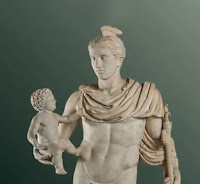Of special interest to me was reading, yet again, about how earlier civilizations have dealt with managing adolescent male energy. It helps to know the Romans also struggled with containing and channeling wild boy energy.
The article centers around an exhibition in the famous Uffizi gallery in Florence, Italy. The exhibits include over 30 statues, funerary objects, and even toys from around Italy and the world. These items speak to the theme of childhood (human and divine) in the Roman world some 2000 years ago. The article offered much about the Uffizi and the Medici collection of art and statues. But there was also a lot of information about how the Romans birthed, raised, and often buried (25% mortality) their children, orphans, and the "children of the poor" and enslaved.
"... a defining moment when a young man
would give up his boyhood clothing
and don the white toga of an adult."
would give up his boyhood clothing
and don the white toga of an adult."
There was brief mention of a rite of passage for an adolescent male. It was called the "Ceremony of the Toga Virilis," which would occur sometime around his 14th year. This was a defining moment when a young man would give up his boyhood clothing and don the white toga of an adult. It led to his acceptance of full Roman Citizenship and stepping into the rights and responsibilities of manhood. I find it hard to believe that a 14-year-old male could simply step into manhood with a change of clothes. I want to believe that clothing swap required training and preparation, but the article does not cover that process.
The article also speaks to the passage lessons and experiences of young women. Many of whom could be engaged at age 12 and married at 13 in relationships arranged by the father.
I liked learning about the perennial conversations, some still relevant today, about how to educate our children, the nature and quality of the education system, and what it took to produce "useful citizens in peace and war."
I guess the deep message here is how we are not alone with the age-old challenges of doing our best for our children, and helping them move toward the ever-illusive adulthood.
SUBSCRIBE: Enter your email address below to have the Man-Making Blog post delivered to you when published.
© Copyright 2005-2022 Earl Hipp. All Rights Reserved.
Sharing with attribution allowed.
Sharing with attribution allowed.


No comments:
Post a Comment
Your response to this blog post is appreciated and welcome. Thanks!